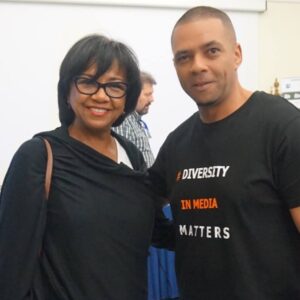“What are you?,” “Where are you from?” Gamey Guilavogui, an actress born to an Italian mother and a father from Guinea, remarks that these are two questions she hears all too often from Italians. Though born in Rome and raised in Italy, Guilavogui is seen as a foreigner by other Italians. Her sense of dislocation, of belonging but not belonging to her country, has made her feel like “crawling out of my own skin” and to “want to be invisible.”
Guilavogui is one of several Italian actors of mixed or non-white origins who appear in “Blaxploitalian: 100 Years of Blackness in Italian Cinema,” a new documentary by Fred Kuwornu, a filmmaker from Bologna who is the son of a Ghanaian father, a surgeon who emigrated to Italy in the ’60s, and an Italian Jewish mother. Kuwornu’s films critically examine the complexities of racial, ethnic, and national identity, as lived by Italians of mixed backgrounds. His first film, “Inside Buffalo” (2010), was a documentary about the 92nd Infantry Division, known as the “Buffalo Soldiers,” an all-black American combat unit that fought in Italy during World War II. Kuwornu made the film after working with Spike Lee on “Miracle at St. Anna,” the director’s 2008 feature film about the 92nd Division.
Then, in 2012, he provoked controversy in Italy, as well as some much-needed public debate, with his second film, “18 Ius Soli: The Right to be Italian,” a critique of Italian citizenship law.
“Blaxploitalian: 100 Years of Blackness in Italian Cinema,” as its title suggests, explores both the presence and exploitation of black actors in Italian film. Through a mix of archival footage and new interviews with actors, Kuwornu’s film covers a lot of ground in just an hour. At its center are the personal accounts of actors working in an industry that pigeonholes them in stereotypical roles, as criminals, terrorists, drug dealers, poor immigrants, prostitutes. But the film also situates their struggles within a larger historical context, that of Italy’s colonial past and its relations with the Africans it once colonized, and their descendants.

Kuwornu was inspired to make “Blaxploitalian” after reading “L’Africa in Italia: Per una controstoria postcoloniale del cinema Italiano” (Africa in Italy: Toward a Postcolonial Counter-history of Italian Cinema), a 2013 collection of critical essays and interviews edited by Leonardo De Franceschi. The film traces the history of black Italian and African representation in Italian movies, beginning with “Salambò,” a 1915 film featuring a black actor who went unidentified in the credits. From the silent film era, Kuwornu goes on to explore movies made under Fascism, postwar Neorealism, the sword-and-sandal epics known in Italy as peplum, commedia all’italiana, ’70s genre films, and contemporary cinema.
The actors interviewed in “Blaxploitalian” include Jonis Bashir, a Somali-Italian; Salvatore Marino, Eritrean-Italian; Livio Beshir, an Egyptian-Italian actor who bears a strong resemblance to Barack Obama; and Germano Gentile, a black Brazilian adopted by an Italian family. Also appearing in the film, along with the previously mentioned Gamey Guilavogui, are the Eritrean-Italian actress Zeudi Araya, and two actresses originally from the Dominican Republic, Iris Peynado, best known for “Non ci resta che piangere” (Nothing Left to Do but Cry), a 1984 comedy written and directed by Massimo Troisi and Roberto Benigni, and Denny Mendez, who made history in 2006 when she became the first Miss Italy of non-Italian origins.
Kuwornu also highlights the contributions to Italian film made by African American actors, like John Kitzmiller, an officer in the 92nd Infantry Division who stayed in Italy after World War II and acted in neorealist films, including “Senza pietà” (Without Pity), in which he played the lead role; “Blaxploitation” film star Fred Williamson, who appeared in Enzo Castellariʼs “The Inglorious Bastards;” and “spaghetti western” mainstay Woody Strode (“Black Jesus”).
As these actors’ experiences attest, the roles offered them were not always demeaning; black characters in Italian films could be sympathetic and even heroic. But more often than not the parts were stereotypical, with black men depicted as physically powerful and violent; black women as alluring, exotic temptresses. And as one of Kuwornu’s interviewees observes, non-white actors were and continue to be offered roles that “exemplify a social problem.” Even John Kitzmiller, for all his success in Italian (and other European) films, often was cast as an angry black man forced to battle racial prejudice.
 “Blaxploitalian” historicizes the status of Afro-Italian and African-descended people (people of African descent) in the Italian imaginary. At one point in the film, Kuwornu remarks that the brutal history of Italian colonialism in Africa has been “erased from popular memory”; in place of historical truth, Italian cinema offered images of savagery, exoticism, and racial inferiority. Kuwornu observes that in “Harlem Knockout,” a propaganda film made when Mussolini was trying to establish a new empire in Africa, blacks were “infantilized and denied language.”
“Blaxploitalian” historicizes the status of Afro-Italian and African-descended people (people of African descent) in the Italian imaginary. At one point in the film, Kuwornu remarks that the brutal history of Italian colonialism in Africa has been “erased from popular memory”; in place of historical truth, Italian cinema offered images of savagery, exoticism, and racial inferiority. Kuwornu observes that in “Harlem Knockout,” a propaganda film made when Mussolini was trying to establish a new empire in Africa, blacks were “infantilized and denied language.”
Decades later, in the ’70s, the Italian film industry was forced not only to compete with foreign, mostly American, films, but also with television. The “art” films of the preceding decades fell out of favor, and the industry turned out many low-budget genre films — horror, crime and action dramas and so-called “trash films,” comedies of little or no artistic value. Trash films, however, often confronted societal taboos, and especially sexual ones. Black actresses found work in these films, but the roles almost always were stereotypical – “the woman of the drug dealer,” as one of Kuwornu’s interviewees remarks.
In the early ’90s, public consciousness about racism in Italy began to stir; after a South African migrant farm worker was murdered in 1989, there were large anti-racism demonstrations in Italian cities. “Pummarò,” a film directed by the popular actor Michele Placido, was an early cinematic depiction of a reality most Italians kept out of sight and mind: the plight of the destitute African laborers who pick crops in southern Italy. The film’s characters included a young Ghanaian who searches for his missing brother, an immigrant farm laborer and a black physician. But Placido’s film, though sympathetic, presented African immigrants as a social problem. Successive films would continue to represent them in that manner, rather than as part of the social fabric of Italy.
As the actors and actresses in “Blaxploitalian” affirm, the paucity of good, non-stereotypical roles remains the status quo they must contend with. “Why can’t I play a police commissioner?” one wonders.
Starting in late January and throughout February 2017 — Black History Month — Kuwornu has been screening “Blaxploitalian” across the United States. By the end of February, he had already shown the film in 13 US cities (including New York, Los Angeles, San Diego, Miami, Houston, Las Vegas and Salt Lake City) and in a variety of venues, from campuses to film festivals to museums. In March, he will bring his movie to Tufts University in Massachusetts and to the University of Toronto before another series of screenings all over United States. Thanks to the Internet and social media, he and I were able to find time in his hectic schedule to discuss the film and its reception.
In New York, where Kuwornu now lives, he screened “Blaxploitalian” at New York University’s Casa Italiana and at the Museum of the Moving Image, in Queens.
“The two audiences were totally different,” he said. “At Casa Italiana, we had a lot of people who love and appreciate Italian culture so the Q&A [question and answer session] after the film was much more about multicultural, contemporary Italy, Italy’s diversity and the presence of Afro-Italians. There were a lot of questions about Afro-Italians. At the museum, the audience came mostly from the black community; there the Q&A was more about the African diaspora, not only in Italy but around the world.”
One audience he evidently didn’t attract was Italian Americans — they appeared to be scarce at both screenings. When I first interviewed Kuwornu nearly two years ago, for another publication, he told me that some Italian Americans had reacted negatively to him and to his earlier films. It seemed that they could not conceive of Italians as anything but white. Some were shocked to hear and see a black man speak with an Italian accent and gesture as an Italian. Their reluctance to recognize the existence of black Italians and black Italian identity is all too reminiscent of the situation in Italy.

“Blaxploitalian” is about more than the images of non-white Italians in Italian media and popular culture; as the film points out, the lack of diversity in representation is a global problem. (Last year’s #OscarsSoWhite social media campaign protested the complete exclusion of black actors and actresses from the 2016 Academy Award nominations.) Moreover, the issue doesn’t affect only black people; Kuwornu notes that Latinos are both under-represented and stereotyped in the US, and he adds that it wasn’t long ago that Italian Americans were depicted almost entirely through negative images. “This documentary is trying to say that every country has to deal with problem of underrepresentation of many social groups.”
“I don’t think our media in Italy have a clear idea of what policy to adopt,” Kuwornu observes. He cites as a potential model the British Broadcasting Corporation’s diversity strategy, which sets targets for black, Asian and ethnic minorities both on-screen and in the BBC workforce. Kuwornu suggests that Italy’s national RAI television network and film production division might adopt the British approach as a way to “fix this issue.” (Some commentators, however, have criticized the BBC for unclear goals and misleading evaluation data.)
“Blaxploitalian” criticizes the Italian film and TV industries, the directors and casting directors for a “mental laziness” that blinds them to the reality of contemporary Italy and constricts their vision of the roles non-white actors might play. There are, however, some signs of change. Kuwornu says he recently was contacted by an Ethiopian-Italian actress who told him that she had gotten a call to audition for the role of a police detective. “The casting director had seen ‘Blaxploitalian’ and said he was really inspired by the movie. He said [to the actress], ‘I can do that, I can do something different.’ How nice that this casting director decided to think outside the box.”
Kuwornu says this is exactly the effect he hopes his film will have, “to change the ideas and minds of many people who work as directors, casting directors and producers, to accept that they have to renovate the workforce, that they should give chances to new people, to involve people from diverse backgrounds.”

Italian casting directors aren’t the only entertainment industry figures who have seen “Blaxploitalian.” Cheryl Boone Isaacs, the African-American president of the Academy of Motion Pictures Arts and Sciences (the Oscars) attended a screening at the 2016 Ischia Global Film and Music Festival. She and actor Danny Glover also participated in a panel discussion with Kuwornu at the festival.
Even as he screens and promotes “Blaxploitalian,” Fred Kuwornu is developing several other projects for his production company, Do the Right Films. (The company’s name is an obvious nod to “Do the Right Thing,” the 1989 film by Kuwornu’s hero and inspiration, Spike Lee.) One is a documentary about James Senese, a musician who founded and leads the band Napoli Centrale; Senese’s mother was Neapolitan, his father an African-American soldier stationed in Italy during World War II. Kuwornu currently is raising funding for the film and hasn’t yet begun production. The other project is a film about Italian immigration to America centered on The Hill, a predominantly Italian American neighborhood in St. Louis. Two of The Hill’s most famous residents were baseball greats Yogi Berra and Joe Garagiola. (Berra’s famous witticism, “No one goes there anymore; it’s too crowded” referred to one of The Hill’s Italian restaurants that, in his view, had become too popular.)
Kuwornu says he will focus the film around a long-running bocce club in The Hill. “I want to tell the story of Italian immigration and the Italian American community using the bocce club because I think that bocce ball is very cinematic,” he says. “We will hear the stories of emigration from the Italians in the club.”
Watch the trailer of “Blaxploitalian”.
For more information about Fred Kuwornu and “Blaxploitalian”, visit his website.











